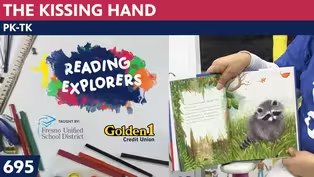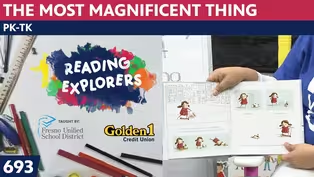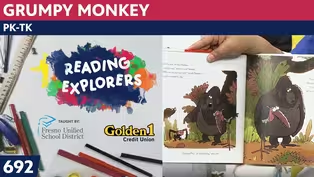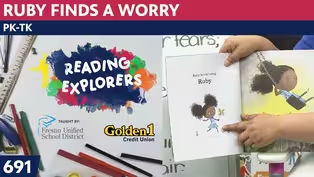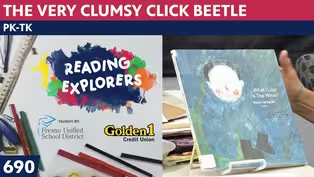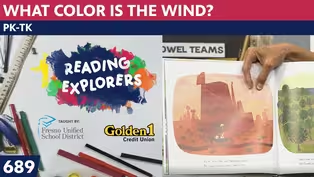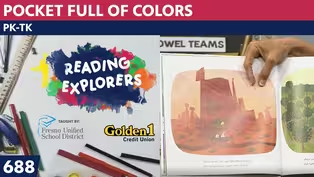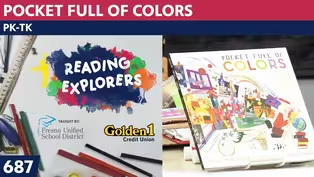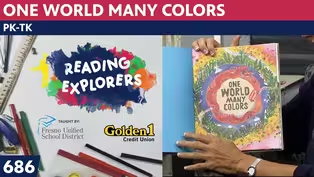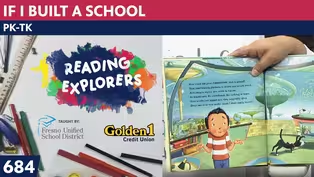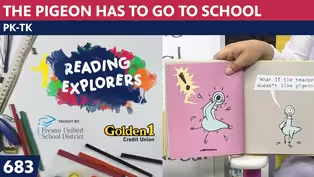
TK-357: 2 is for Pez Dispenser by Jean-Michel Basquiat
Season 3 Episode 316 | 14m 9sVideo has Closed Captions
Join Mrs. Readwright at Camp Discovery!
Transitional Kindergarten teacher, Mrs. Readwright, welcomes students back to Camp Discovery, a fun learning space packed with reading adventures & fun games!
Problems playing video? | Closed Captioning Feedback
Problems playing video? | Closed Captioning Feedback
Reading Explorers is a local public television program presented by Valley PBS

TK-357: 2 is for Pez Dispenser by Jean-Michel Basquiat
Season 3 Episode 316 | 14m 9sVideo has Closed Captions
Transitional Kindergarten teacher, Mrs. Readwright, welcomes students back to Camp Discovery, a fun learning space packed with reading adventures & fun games!
Problems playing video? | Closed Captioning Feedback
How to Watch Reading Explorers
Reading Explorers is available to stream on pbs.org and the free PBS App, available on iPhone, Apple TV, Android TV, Android smartphones, Amazon Fire TV, Amazon Fire Tablet, Roku, Samsung Smart TV, and Vizio.
Providing Support for PBS.org
Learn Moreabout PBS online sponsorshipMore from This Collection
Valley PBS and Fresno Unified School District have partnered with Golden 1 Credit Union to create Reading Explorers Lessons for grades Pre-Kindergarten through Third grade. The daily lessons will be taught by Fresno Unified School District teachers and are created to help students practice their reading skills and reinforce lessons during distance learning.
Video has Closed Captions
Valley PBS presents Reading Explorers Lessons for Pre-Kindergarten and TK. (26m 27s)
PK-TK-693-The Most Magnificent Thing
Video has Closed Captions
Valley PBS presents Reading Explorers Lessons for Pre-Kindergarten and TK. (26m 26s)
Video has Closed Captions
Valley PBS presents Reading Explorers Lessons for Pre-Kindergarten and TK. (26m 28s)
Video has Closed Captions
Valley PBS presents Reading Explorers Lessons for Pre-Kindergarten and TK. (26m 28s)
PK-TK-690: The Very Clumsy Click Beetle
Video has Closed Captions
Valley PBS presents Reading Explorers Lessons for Pre-Kindergarten and TK. (26m 22s)
PK-TK-689: What Color is the Wind?
Video has Closed Captions
Valley PBS presents Reading Explorers Lessons for Pre-Kindergarten and TK. (26m 21s)
PK-TK-688: Pocket Full of Colors
Video has Closed Captions
Valley PBS presents Reading Explorers Lessons for Pre-Kindergarten and TK. (25m 58s)
PK-TK-687: Dancing Through Fields of Colors
Video has Closed Captions
Valley PBS presents Reading Explorers Lessons for Pre-Kindergarten and TK. (26m 20s)
PK-TK-686: One World Many Colors
Video has Closed Captions
Valley PBS presents Reading Explorers Lessons for Pre-Kindergarten and TK. (27m 13s)
PK-TK-685: School is Wherever I am
Video has Closed Captions
Valley PBS presents Reading Explorers Lessons for Pre-Kindergarten and TK. (26m 32s)
PK-TK-684: If I Built a School
Video has Closed Captions
Valley PBS presents Reading Explorers Lessons for Pre-Kindergarten and TK. (26m 21s)
PK-TK-683: The Pigeon Has to Go to School
Video has Closed Captions
Valley PBS presents Reading Explorers Lessons for Pre-Kindergarten and TK. (26m 22s)
Providing Support for PBS.org
Learn Moreabout PBS online sponsorship♪ Good morning to a brand new day ♪ ♪ Time to learn and games you play ♪ ♪ Learning things is so much fun ♪ ♪ Learning is good for everyone ♪ (bright up beat music) - Hello early learners, welcome back to the art room.
You know how we did 26 days of the ABCs of arts?
Well, now we're doing the one, two, three of art.
And let's start out with our hello song.
♪ Hello nice to see you everyone ♪ ♪ Hello nice to see you everyone ♪ ♪ Hello to you hello to you ♪ ♪ Hello to you hello to me ♪ ♪ Hello nice to see you everyone ♪ Well, yesterday we learned about Andy Warhol and his series of endangered animal pictures, and today we're going to study an artist that was similar to Andy Warhol in that he was a pop artist.
And he started out as a graffiti duo.
He and another fellow were using spray cans and doing art on buildings in New York city.
And they became famous, so famous that gallery owners saw their work and asked them to paint inside their museum and art gallery.
So they became known as the graffiti artists of New York city.
Well, this that we're going to be looking at today, is called Pez dispenser.
And if you know anything about the little candy that goes into the thing and you lift back the lid and the candy sticks out, and you could take that one.
This picture that he did, to me looks more like a Tyrannosaurus rex.
But I guess if you push back on his head, candy can come out of his mouth.
Let's take a look at it, the picture of our artist.
And here he is, this is his grownup picture.
There are pictures of him where he has lots of braids and dreadlocks, and he changed his look a lot.
In his artwork that he does of himself, he often puts a crown on himself.
He's known for putting a crown on many of the characters in his work.
And his name is Jean-Michel Basquiat.
Does that look like a name that comes from the United States?
He was born in the United States, but one of his parents was from Haiti and his other parent was from Puerto Rico, and they named him Jean-Michel Basquiat.
And Jean-Michel is no longer living.
He died as a young man, but his artwork is lots of places.
And I brought a book that Maya Angelou wrote poems and put his artwork, illustrating it, let me grab it.
It's called Life Doesn't Frighten Me and it's poems by Maya Angelou.
And the paintings are by Jean-Michel Basquiat.
So if your teacher wants to look at this poem book and look at a lot of different art, and she's saying to the people, that doesn't frighten me, that doesn't frighten me, nothing frightens her in her poem.
but a lot of the artwork is super, super interesting to look at.
And we're also talking about the one, two, threes of art.
If your teacher wants to check this one out at the library too, this is The Radiant Child, and this is the story of his whole life.
Which is really a great book.
And if you are on my Facebook page, I have a link to all of these books.
So, you can take a look at those.
But let's look at this song.
About the one, two, three, four, five of art.
This is number two.
Number one was one zebra.
Number two is this Pez dispenser that I put the crown above.
I counted that as one, and the Pez dispenser is two.
Here we go.
♪ One two three four five of art ♪ ♪ That's the way that we will start ♪ ♪ One is for zebra ♪ ♪ Two is for Pez ♪ ♪ Three is for pears ♪ ♪ That's what Cezanne on says ♪ ♪ Four is for hearts painted by Jim Dine ♪ ♪ That is art and the number line ♪ Now let's look at this painting by Jean-Michel.
I said two is for a crowned dyno, 'cause here's this crown one, and here he is two.
Basquiat created this art called Pez dispenser.
Is his signature crown there?
Oh yes sir.
Cause he even put it over himself.
If he had a photograph of himself, he would have a crown over it.
If he painted himself, he put a crown over it.
Let's take a look at the shapes of this dinosaur that we're going to draw, on a piece of paper and draw the teeth on it.
I'm going to draw the shapes, his head is kind of like a triangle with his mouth open.
It'll go down his back for a long tail and it looks like it even has spikes on it.
So it's not a true Tyrannosaurus rex, even though it has a little short hands and little short legs.
So let's get started with our pastels, oil pastels.
Lemme put things down and get my tabletop up.
I brought my pastels, I brought a piece of white paper, and I'm going to cut out a piece of black paper.
Lemme get these pastels over here.
Put them on my table.
Can use my black outliner pin.
I could use just a piece of white pastel, which I brought to write pieces of the stripes on his body, boy, I really put this up here with a strong clip.
Each time I try and pull him down, it starts to pull the whole chart down.
Wouldn't that be terrible?
If I pulled the whole chart-stand down?
Let's put this here.
So if I draw my black dinosaur on here, I can paste it onto here later.
So I'm just gonna leave my white paper over here, but get started with my skinny broken white pastel.
And here we go.
So his face, and I know his head is going to be up here.
Remember how I've taught you?
We draw with our fingers first, there's his head.
Here's his body, and little room for the legs.
Maybe I need to move it over a little bit so that his tail will fit in there.
All right, so I'm going to do a small diagonal line.
I don't need to worry about the crown, because I am going to paste it with a piece of gold paper.
So here's my part that goes in for the mouth.
I'm going to make it go down.
Do you notice I did a diagonal line?
A curve line down, a V on its side, and then his lower jaws, a little less size width, than his upper part.
Going to go around the back of his head, and down his back, keep going.
I'm gonna go all the way to the corner.
Since I'm cutting this out.
I'm going to go down for his chest.
Oh, I think I need to go in a little bit more, down for his chest, I'm gonna cut that off.
Don't you worry about it.
I'm gonna put out his little tiny paw, and bring it in.
I think it probably had claws on it.
But I didn't put it on there yet.
Now there are his two little front arms.
I'm going to go down for his kind of big belly, go down for his leg and I'm going to put his foot up, go down and you know, your legs can look very different from mine or from Basquiat's.
Doesn't have to look like that.
I think what I'll do, is cut him out, so that I can decorate him.
I'm not gonna cut him out completely, but just so that you can see, maybe I better not.
Maybe I better just do this boys and girls, 'cause I'm afraid I will not leave room for his zigzag, zigzag, zigzag, like a stegosaurus down his back.
Move these over, zig and zag down.
I'm just doing like mountain, mountain and I'm getting down smaller and smaller, as I get to the tip of his tail.
Do you need to do as exact?
Nope.
You make your dinosaur however you want.
I do like the idea of those really kind of spooky red eyes.
And I know that I want to put some nostrils on, two nostrils, and how Basquiat went around his eyes like that, that's what I'm going to do.
He looks friendly now, until I put his pointed sharp teeth in there.
Now he looks kind of wicked, kind of scary.
Like he's gonna bite open like a giant pumpkin or something.
And now he has a big stripe down his body in the front, a big Stripe down on his back, oh even put some zigzags on there.
You decorate it however you think looks great.
I think I want to do some scales, like over his eyebrows, do that, put some claws on, do that.
I'm gonna make this go all the way down his leg.
He even put a big circle and I've read in here, I think I'm gonna make it have a shape that follows along like this.
You can decorate it however you want.
And around the outside he put yellow, starting close to where he, oh, remember soft pastels, they will break, and it went off my paper a little bit, but I'm not worried, 'cause you know, I'm cutting that part off.
Still going around the outside, still adding yellow, and you know, you use any color you want.
I wanna show you what it's gonna look like when I cut it out, so I'm gonna get this started on, my cutting out part, but I can still add more color afterwards.
The part that is a little, oh, I think this goes in here.
The part that is a little difficult is going up and down the zigzags to cut it out.
So I wanna teach you how I get close to the zigzag, before I start cutting it out on the inside, going up and down, up and down.
Look, I'm adding a little yellow and some peach.
Oh, I bet orange would look good in there.
That orange is pretty bright in my box of pastels.
You can use whatever color you want, and you notice I'm kind of doing it in a rainbow way.
Let me show you what I meant about cutting.
I cut close to it like this without cutting around there.
But the closer I get to the edge of my zigzags, now notice, I can zig in, I can zig in, and make it meet it.
And look how much easier it is to pull out the pieces that I cut.
Zig in, zig in and pull it out.
This is so much easier 'cause look, if I try and go in here, and then turn my scissors and then go this way, because we always know that our thumb stays on top.
So I can't very well make my thumb on top, if I am turning my scissors around, try and get into all these places.
Boys and girls I'll finish cutting this out, and you will see when we come back, I will put it on my white paper and it will stand out even more.
Now this is number two, tomorrow when we do number three, we're going to do pairs, pairs with Cezanne.
And I'm going to use white paper, I'm going to bring recycled magazine pieces.
So maybe tonight, go through your magazines and find a lot of light green color.
I cut it out of trees in the magazine, I put all different colors of green, 'cause we're going to make a giant pair.
And you're going to cut and paste lots of pieces of green in a collage.
So a piece of white paper, recycled magazines, you can bring glue stick and scissors and I'm using a pencil.
So if you'll do that, bring those things and we'll come back and make some pairs, three of them.
Let's sing our goodbye song.
♪ Goodbye see you next time everyone ♪ ♪ Good bye see you next time everyone ♪ ♪ Good bye to you goodbye to you ♪ ♪ Good bye to you good bye to me ♪ ♪ Good bye see you next time everyone ♪ See you tomorrow boys and girls.
Bye bye now.
♪ Good morning to a brand new day ♪ ♪ Time to learn and games to play ♪ ♪ Learning things is so much fun ♪ ♪ Learning is good for everyone ♪
Support for PBS provided by:
Reading Explorers is a local public television program presented by Valley PBS
